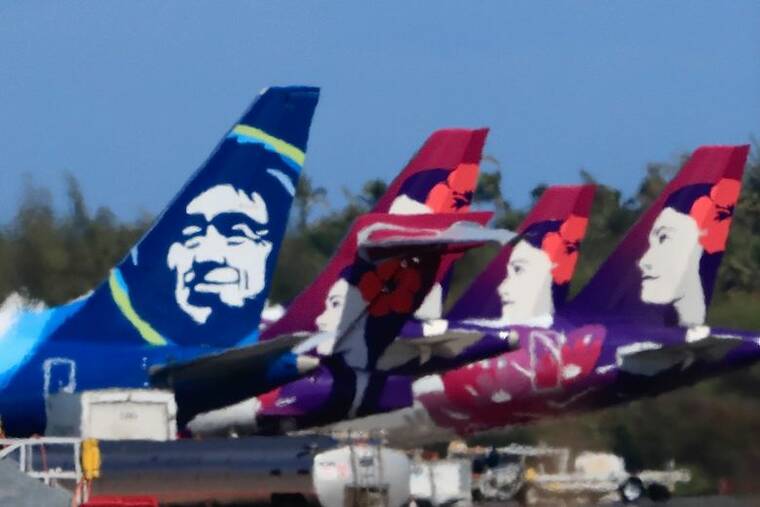A proposed $1.9 billion merger between competitors Alaska and Hawaiian airlines has cleared its final hurdle with the U.S. Department of Transportation today announcing that it was granting approval for the airlines to combine and operate international routes under one certificate – authorization required to provide air transportation as a merged carrier.
The clearance, which includes protections for travelers, comes about a month after the U.S. Justice Department ended it’s formal review period for the proposed merger under the Hart-Scott-Rodino Act.The DOJ enforces Section 7 of the Clayton Act, which prohibits mergers and acquisitions that could substantially lessen competition or create a monopoly.
However, if the DOT had denied the joint application that Alaska and Hawaiian made on July 15, the airlines could not have combined.
When the DOT announced that the merger was moving forward today, it said in a statement that it had secured “binding, enforceable public-interest protections from Alaska Airlines and Hawaiian Airlines prior to the close of their merger. The protections, necessary for the Department’s consideration of the airlines’ needed approvals, are aimed at preventing harms to the traveling public, rural communities, and smaller airline competitors.”
The DOT added that, “Alaska and Hawaiian are required to protect the value of rewards, maintain existing service on key Hawaiian routes to the continental United States and inter-island, preserve support for rural service, ensure competitive access at the Honolulu hub airport, guarantee fee-free family seating and alternative compensation for controllable disruptions, and lower costs for military families.”
U.S. Transportation Secretary Pete Buttigieg said in a statement,”Our top priority is protecting the traveling public’s interest in this merger. We have secured binding protections that maintain critical flight services for communities, ensure smaller airlines can access the Honolulu hub airport, lower costs for families and service members, and preserve the value of rewards miles against devaluation,” said “This more proactive approach to merger review marks a new chapter of DOT’s work to stand up for passengers and promote a fairer aviation sector in America.”
Hawaiian and Alaska are expected to soon complete the merger, which was approved on Dec. 2 by the boards of directors of both air carriers. The process, which has included lawsuits and high-level federal and state reviews, so far has taken about nine months.
Hawaiian shareholders, who approved the merger on Feb. 16, will get $18 a share in cash as part of the deal, which includes $900 million in Hawaiian debt. Hawaiian’s stock this morning was very near that price, an indication to some that investors had confidence that the deal would go through.
The deal is expected to shore up Hawaiian’s financial performance, which has been strained since at least COVID-19. Hawaiian reported a second-quarter net loss of $1.30 a share, or $67.6 million, as compared with a $12.3 million net loss a year ago. When adjusted for nonrecurring costs, the second-quarter loss came to $1.37 a share.
After it completes the financial terms of the deal, Alaska Air Group Inc., the parent company of Alaska Airlines, will also commonly own and control Hawaiian. It’s still unclear how the merger will impact Hawaiian’s 7,400 employees. Union members are expected to keep their jobs,however,it’s anticipated that the carrier’s top leadership team will undergo change.
The DOT’s approval of the airlines’ joint application means that the carriers may move forward on combining under a single FAA operating certificate.
In their application, the airlines said that they planned to keep “both the Alaska and Hawaiian brands, retaining consumer choice while offering integrated and seamless loyalty benefits and customer service.”
Hawaii, where Hawaiian Airlines has a history that goes back to 1929. Hawaiian Airlines is the state’s largest carrier, with about 150 daily interisland flights and over 230 systemwide. It offers nonstop flights between Hawaii and 16 U.S. gateway cities, and service to American Samoa, Australia, the Cook Islands, Japan, New Zealand, South Korea and Tahiti.
Alaska Airlines and its regional partners serve over 120 destinations across the United States, Belize, Canada, Costa Rica, Mexico, the Bahamas and Guatemala.
Completion of the merger is expected to happen quickly, and once it does, the combined airlines, “will serve 54.7 million passengers annually and operate to 138 destinations, including nonstop service to 29 top international destinations in the Americas, Asia, Australia, and the South Pacific,” according to their joint application agreement.

